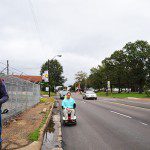Despite a mere 1.2 percent of people walking to work, Orlando tops the list of most dangerous places because of its high pedestrian fatalities, a recent report finds.
 Entitled “Dangerous by Design 2011” the report authored by Transportation for America, the largest and most diverse coalition working on transportation reform in America, reveals the Orlando metro area had a pedestrian fatality rate of 3.0 per 100,000 people over the decade 2000-2009.
Entitled “Dangerous by Design 2011” the report authored by Transportation for America, the largest and most diverse coalition working on transportation reform in America, reveals the Orlando metro area had a pedestrian fatality rate of 3.0 per 100,000 people over the decade 2000-2009.
The report analyzes 10 years of pedestrian fatalities in each county and calculates a Pedestrian Danger Index (PDI)–a ratio of the pedestrian fatality rate to the portion of the population that walks to work–and ranks 52 of the largest metropolitan areas in the U.S. The ten-year PDI reveals long-term trends in the pedestrian safety problem.
Between 2000-2009, total pedestrian deaths in the Orlando metro area were 557, resulting is a dismal 255.4 on Transportation for America’s PDI.
While Orlando grabs the number one spot as the most dangerous large metro area for pedestrians, three other major cities in Florida each claim the top three spots. The Tampa-St. Petersburg-Clearwater area is the second most dangerous with a PDI of 212.7. Jacksonville comes in third place with 342 pedestrian deaths between 2000-2009 and a PDI of 177.8; Miami-Fort Lauderdale-Pompano Beach is the fourth most dangerous metro area for pedestrians with 1,555 fatalities over the past 10 years and a PDI of 167.9.
Hispanics suffered a pedestrian death rate of 2.23 per 100,000 persons from 2000 through 2007, a rate nearly 62 percent higher than the 1.38 per 100,000 persons rate for non-Hispanic whites. Similar data from the Centers for Disease Control and Prevention (CDC) show that rates for African-American were even higher at 2.39 per 100,000 persons, a rate more than 73 percent higher than for non-Hispanic whites.
The report makes several recommendations that should be included in the next federal transportation spending bill. These include:
- Retain dedicated federal funding for the safety of people on foot or on bicycle
- Adopt a national complete streets policy
- Create more complete networks of sidewalks, bicycle paths and trails so that residents can travel safely through an area
- Hold states accountable for creating communities that are safe for walking.


